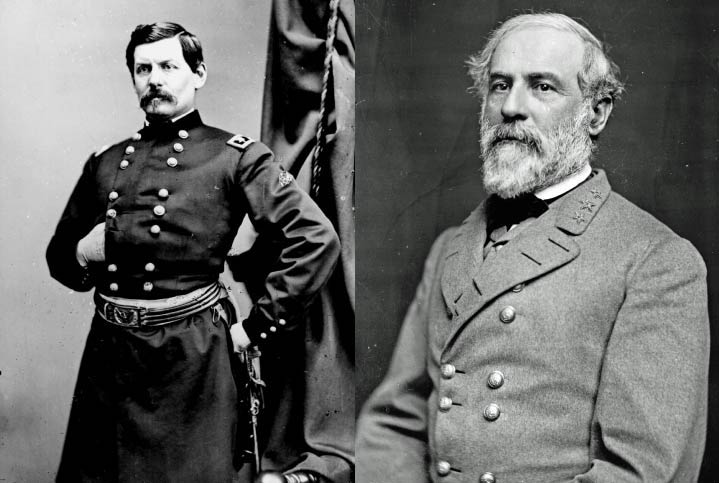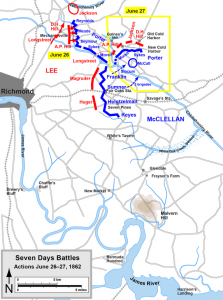| Seven Days Battles | |||||||
|---|---|---|---|---|---|---|---|
 |
|||||||
|
|||||||
| Contenders | |||||||
| Military Leaders | |||||||
| George B. McClellan | Robert E. Lee | ||||||
| Military Units in Battle | |||||||
| Army of the Potomac | Army of Northern Virginia | ||||||
| Unit Strength | |||||||
| 104,100 | 92,000 | ||||||
| Casualties and Deaths | |||||||
| Total: 15,855 | Total: 20,204 | ||||||
|
1,734 killed 8,066 wounded 6,055 missing/captured |
3,494 killed 15,758 wounded 952 missing/captured |
||||||
| Part of the American Civil War | |||||||
The Seven Days Battles, also known as Seven Days Campaign was a sequence of 6 battles, that took place from June 25 to July 1, 1862, along Virginia Peninsula in the American Civil War. Here, the army of Northern Virginia under the leadership of General Robert E. Lee, took to the offensive against the Union Army of the Potomac under the leadership of Major General George B. McClellan. During this battle, McClellan’s army, which initially consisted of 100,000 men, ended up suffering with almost 16,000 casualties; while Lee’s army had over 20,000 casualties.
June 25
This marked the beginning of the battle, whereby, McClellan made his first move. His initial plan was to place siege guns near Old Traven, but he would have to take Old Traven by physical attack. He wanted the Confederates at the south of Old Traven cleared out before he could secure his left flank. To achieve this, he dispatched 2 groups commanded by Generals Philip Kearny and Joseph Hooker. These groups marched west along Williamsburg Road from Seven Pines. They came across Confederate General Benjamin Huger’s division near Oak Grove. Although the two groups made initial progress, Huger’s division made a stiffening resistance and a side attack which halted them; leaving the lines basically unchanged at the end of day one. General Lee’s plan was to make McClellan passive. So after the first attack, he executed his plan whereby, 25,000 Confederates would be at south of Chickahominy, while 65,000 would be placed north of the river to attack Porter. This first attack enabled McClellan to gain 600 yards at a cost of more than 1000 casualties on both sides.
June 26
Lee’s plan called for Confederate General Jackson and his army to march east from the valley to attack Porter in the morning of June 26. McClellan received the news of Jackson’s approach and immediately ordered Hooker and Kearny to call off any assaults on Old Traven. This resulted to a calm day, since McClellan no longer targeted Old Traven while Lee waited for Jackson. Lee’s plan relied on Jackson’s meeting up with his army on the Chickahominy River and conveying a message to A.P. Hill who was followed by 2 army groups led by D. H. Hill and James Longstreet. A.P. Hill was to cross the river and march through Mechanicsville and attack Porter. Unfortunately, Jackson was delayed, but A.P. Hill along with a brigade from D. H. Hill’s division pushed on with the attack nevertheless. On arrival of Jackson, McClellan got worried and knew that his line was too vulnerable. However, McClellan ordered Porter to remain at Boatswain’s Swamp as he prepared a change of base. Moreover, he cancelled an attack on south of the Chickahominy even though he outnumbered Lee’s men by a ratio of 2:1.
June 27
In the morning of the third day, Confederates positioned at north of Chickahominy pursued the withdrawing Union army. A.P. Hill and Longstreet moved southeast to lock Porter, while D. H. Hill and Jackson moved northeast to turn Porter’s flank. Jackson’s movement did not turn Porter’s flank since Porter was at Boatswain’s Swamp which is farther east. Confederates charged throughout the day with little effect until in the evening when D. H. Hill and Jackson arrived. The two groups made simultaneous but uncoordinated attacks, which finally broke Porter’s position. At the south of the river, there was little happening throughout the day. However, Confederate General Magruder’s men attacked the Union line at Garnett’s Farm, although they forced away. Later on, General McClellan announced his move to the James.
June 28
There was stillness on the fourth day as Lee waited to see what action McClellan would take. Some of Magruder’s men attacked again near Gouldin’s and Garnett’s farms, but achieved little results. Meanwhile, on his way to the James, McClellan packed his trains and destroyed unnecessary supplies. That evening, Lee ordered for the pursuit, whereas Magruder and Benjamin Huger would pursue the Union rear guard. Jackson and D. H. Hill would cross the Chickahominy and stay north and east of the army, while Longstreet and A.P. Hill would surround the rest of the army to cut off the Union retreat.
June 29
On June 29th, Confederates at the south of Chickahominy found empty Union trenches and proceeded with their pursuit. A.P. Hill and Longstreet marched 20 miles to be in position, but Benjamin got conflicting orders and marched all day long. On the other hand, Jackson thought that he was to stay north of the Chickahominy instead of crossing the river, while Magruder alternated between assault and worry that he would be attacked by the Union troops and therefore spent the day marching back and forth. Magruder eventually attacked the Union from behind at Savage’s Station. Union General Samuel Heintzelman continued retreating and left Union general Edwin Sumner’s Second Corps and another group behind. These two groups managed to halt Magruder despite his initial success. The rest of Union’s army marched toward the James during the day, while the rear guard followed at night.
June 30
June 30th marked the peak of Lee’s pursuit plan. Meanwhile, McClellan positioned more than half of his troop near the Glendale crossroads. Lee’s plan was to have Jackson and D.H. Hill force the Union troops guarding White Oak Swamp Bridge to stay north of Glendale, while Huger would also do the same on the Charles City Road. Magruder was to join A.P. Hill and Jackson if he could move faster, and then they would drive toward the Willis Church Road to cut McClellan’s retreat route. On the material day, Jackson contented himself with an attack at White Oak Swamp bridge, enabling many Union troops to reinforce the Glendale lines. Magruder and Huger spent the whole day marching to no effect. Longstreet and A.P. Hill pushed on with their attack plan, although they were unsupported. Initially, they broke the Union line but due to Huger’s and Jackson’s failure, they were pushed back later on. The victorious Union army joined the rest of the troop on a comparatively safe ground at Malvern Hill.
July 1
The Army of the Potomac had reached the James by July 1 and united there. The army’s main line was on Malvern Hill, boasting a bluff overlooking the river and an open gentle north slope. The Confederates pursued slowly, as Lee was very cautious about approaching the area he recognized well from his youth. He also wanted to attack only if an artillery concentration, which was proposed by Longstreet, was effective. The Union guns prevented such a concentration from happening, but the Confederates, through bad orders and hope, attacked their opponents’ line anyway in the afternoon and early evening. These attacks did not bear any fruits thanks to the sheer power of the artillery managed by Colonel Henry Hunt. This was the fourth day in which McClellan’s troop were holding the field in the day and retreating at night. This time, they retreated toward Harrison’s Landing.
Aftermath
June 2 saw Potomac Army march toward Harrison’s Landing. General Lee pursued the following day after being alerted by Jeb Stuart about McClellan’s retreat from Evelington Heights. By the time when Lee was arriving, McClellan had already moved his troops to the heights. This was the end of the Seven Days Battles. This gave McClellan a good chance to seize Richmond and restore the Union to a status quo which resembled 1860. On the other hand, Confederate spirits rose. Despite several tactical defeats, General Lee had won a calculated victory, keeping the initiative until September 17, 1862 along Antietam Creek, Maryland, where McClellan finally forced him to withdraw.
